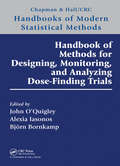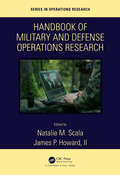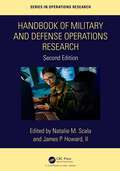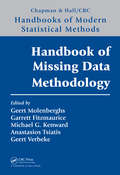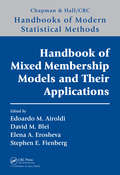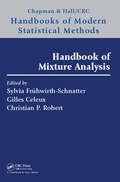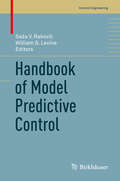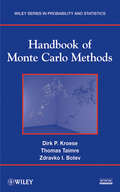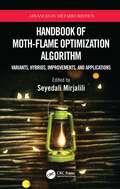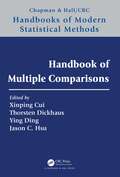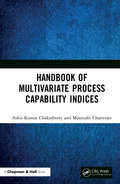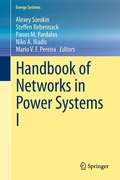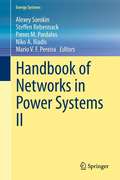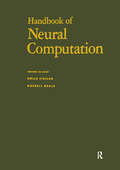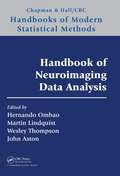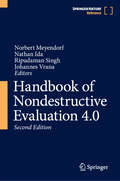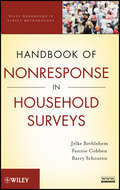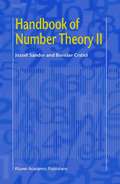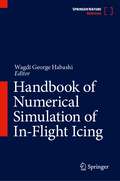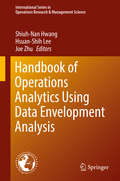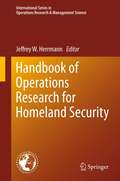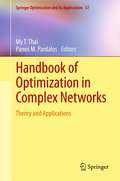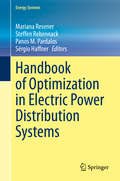- Table View
- List View
Handbook of Methods for Designing, Monitoring, and Analyzing Dose-Finding Trials
by Alexia Iasonos Björn Bornkamp John O'QuigleyHandbook of Methods for Designing, Monitoring, and Analyzing Dose-Finding Trials gives a thorough presentation of state-of-the-art methods for early phase clinical trials. The methodology of clinical trials has advanced greatly over the last 20 years and, arguably, nowhere greater than that of early phase studies. The need to accelerate drug development in a rapidly evolving context of targeted therapies, immunotherapy, combination treatments and complex group structures has provided the stimulus to these advances. Typically, we deal with very small samples, sequential methods that need to be efficient, while, at the same time adhering to ethical principles due to the involvement of human subjects. Statistical inference is difficult since the standard techniques of maximum likelihood do not usually apply as a result of model misspecification and parameter estimates lying on the boundary of the parameter space. Bayesian methods play an important part in overcoming these difficulties, but nonetheless, require special consideration in this particular context. The purpose of this handbook is to provide an expanded summary of the field as it stands and also, through discussion, provide insights into the thinking of leaders in the field as to the potential developments of the years ahead. With this goal in mind we present: An introduction to the field for graduate students and novices A basis for more established researchers from which to build A collection of material for an advanced course in early phase clinical trials A comprehensive guide to available methodology for practicing statisticians on the design and analysis of dose-finding experiments An extensive guide for the multiple comparison and modeling (MCP-Mod) dose-finding approach, adaptive two-stage designs for dose finding, as well as dose–time–response models and multiple testing in the context of confirmatory dose-finding studies.? John O’Quigley is a professor of mathematics and research director at the French National Institute for Health and Medical Research based at the Faculty of Mathematics, University Pierre and Marie Curie in Paris, France. He is author of Proportional Hazards Regression and has published extensively in the field of dose finding. Alexia Iasonos is an associate attending biostatistician at the Memorial Sloan Kettering Cancer Center in New York. She has over one hundred publications in the leading statistical and clinical journals on the methodology and design of early phase clinical trials. Dr. Iasonos has wide experience in the actual implementation of model based early phase trials and has given courses in scientific meetings internationally. Björn Bornkamp is a statistical methodologist at Novartis in Basel, Switzerland, researching and implementing dose-finding designs in Phase II clinical trials. He is one of the co-developers of the MCP-Mod methodology for dose finding and main author of the DoseFinding R package. He has published numerous papers on dose finding, nonlinear models and Bayesian statistics, and in 2013 won the Royal Statistical Society award for statistical excellence in the pharmaceutical industry. ? ?
Handbook of Military and Defense Operations Research (Chapman & Hall/CRC Series in Operations Research)
by Ii James P. Howard Natalie M. ScalaOperations research (OR) is a core discipline in military and defense management. Coming to the forefront initially during World War II, OR provided critical contributions to logistics, supply chains, and strategic simulation, while enabling superior decision-making for Allied forces. OR has grown to include analytics and many applications, including artificial intelligence, cybersecurity, and big data, and is the cornerstone of management science in manufacturing, marketing, telecommunications, and many other fields. The Handbook of Military and Defense Operations Research presents the voices leading OR and analytics to new heights in security through research, practical applications, case studies, and lessons learned in the field. Features Applies the experiences of educators and practitioners working in the field Employs the latest technology developments in case studies and applications Identifies best practices unique to the military, security, and national defense problem space Highlights similarities and dichotomies between analyses and trends that are unique to military, security, and defense problems
Handbook of Military and Defense Operations Research (Chapman & Hall/CRC Series in Operations Research)
by James P. Howard Natalie M. ScalaTracing its roots back to World War II, operations research (OR) has become a vital tool in military and defense strategy. The second edition of the Handbook of Military and Defense Operations Research highlights this evolution, showcasing how OR integrates with cutting-edge areas like artificial intelligence, cybersecurity, and big data analytics.This volume is more than a historical account; it is a practical guide. The volume features expert voices and offers insights into OR applications in modern security challenges. Readers will discover a blend of theory and real-world case studies, making it an essential resource for both newcomers and seasoned defense analysis professionals.Dive into this handbook to explore the rich, dynamic field of military and defense operations research, a discipline at the heart of global security and strategic decision-making.New to the second edition: Reorganized into a three-part structure Extensive revisions throughout Numerous new exercises, examples, and case studies Several new chapters
Handbook of Missing Data Methodology (Chapman & Hall/CRC Handbooks of Modern Statistical Methods)
by Geert Molenberghs Michael G. Kenward Garrett Fitzmaurice Anastasios Tsiatis Geert VerbekeMissing data affect nearly every discipline by complicating the statistical analysis of collected data. But since the 1990s, there have been important developments in the statistical methodology for handling missing data. Written by renowned statisticians in this area, Handbook of Missing Data Methodology presents many methodological advances and t
Handbook of Mixed Membership Models and Their Applications (ISSN)
by Stephen E. Fienberg Edoardo M. Airoldi Elena A. Erosheva David M. BleiIn response to scientific needs for more diverse and structured explanations of statistical data, researchers have discovered how to model individual data points as belonging to multiple groups. Handbook of Mixed Membership Models and Their Applications shows you how to use these flexible modeling tools to uncover hidden patterns in modern high-dim
Handbook of Mixture Analysis (ISSN)
by Sylvia Frühwirth-Schnatter, Gilles Celeux and Christian P. RobertMixture models have been around for over 150 years, and they are found in many branches of statistical modelling, as a versatile and multifaceted tool. They can be applied to a wide range of data: univariate or multivariate, continuous or categorical, cross-sectional, time series, networks, and much more. Mixture analysis is a very active research topic in statistics and machine learning, with new developments in methodology and applications taking place all the time. The Handbook of Mixture Analysis is a very timely publication, presenting a broad overview of the methods and applications of this important field of research. It covers a wide array of topics, including the EM algorithm, Bayesian mixture models, model-based clustering, high-dimensional data, hidden Markov models, and applications in finance, genomics, and astronomy.Features: Provides a comprehensive overview of the methods and applications of mixture modelling and analysis Divided into three parts: Foundations and Methods; Mixture Modelling and Extensions; and Selected Applications Contains many worked examples using real data, together with computational implementation, to illustrate the methods described Includes contributions from the leading researchers in the field The Handbook of Mixture Analysis is targeted at graduate students and young researchers new to the field. It will also be an important reference for anyone working in this field, whether they are developing new methodology, or applying the models to real scientific problems.
Handbook of Model Predictive Control (Control Engineering)
by Saša V. Raković William S. LevineRecent developments in model-predictive control promise remarkable opportunities for designing multi-input, multi-output control systems and improving the control of single-input, single-output systems. This volume provides a definitive survey of the latest model-predictive control methods available to engineers and scientists today. The initial set of chapters present various methods for managing uncertainty in systems, including stochastic model-predictive control. With the advent of affordable and fast computation, control engineers now need to think about using “computationally intensive controls,” so the second part of this book addresses the solution of optimization problems in “real” time for model-predictive control. The theory and applications of control theory often influence each other, so the last section of Handbook of Model Predictive Control rounds out the book with representative applications to automobiles, healthcare, robotics, and finance. The chapters in this volume will be useful to working engineers, scientists, and mathematicians, as well as students and faculty interested in the progression of control theory. Future developments in MPC will no doubt build from concepts demonstrated in this book and anyone with an interest in MPC will find fruitful information and suggestions for additional reading.
Handbook of Monte Carlo Methods
by Dirk P. Kroese Thomas Taimre Zdravko I. BotevA comprehensive overview of Monte Carlo simulation that explores the latest topics, techniques, and real-world applications More and more of today's numerical problems found in engineering and finance are solved through Monte Carlo methods. The heightened popularity of these methods and their continuing development makes it important for researchers to have a comprehensive understanding of the Monte Carlo approach. Handbook of Monte Carlo Methods provides the theory, algorithms, and applications that helps provide a thorough understanding of the emerging dynamics of this rapidly-growing field. The authors begin with a discussion of fundamentals such as how to generate random numbers on a computer. Subsequent chapters discuss key Monte Carlo topics and methods, including: Random variable and stochastic process generation Markov chain Monte Carlo, featuring key algorithms such as the Metropolis-Hastings method, the Gibbs sampler, and hit-and-run Discrete-event simulation Techniques for the statistical analysis of simulation data including the delta method, steady-state estimation, and kernel density estimation Variance reduction, including importance sampling, latin hypercube sampling, and conditional Monte Carlo Estimation of derivatives and sensitivity analysis Advanced topics including cross-entropy, rare events, kernel density estimation, quasi Monte Carlo, particle systems, and randomized optimization The presented theoretical concepts are illustrated with worked examples that use MATLAB®, a related Web site houses the MATLAB® code, allowing readers to work hands-on with the material and also features the author's own lecture notes on Monte Carlo methods. Detailed appendices provide background material on probability theory, stochastic processes, and mathematical statistics as well as the key optimization concepts and techniques that are relevant to Monte Carlo simulation. Handbook of Monte Carlo Methods is an excellent reference for applied statisticians and practitioners working in the fields of engineering and finance who use or would like to learn how to use Monte Carlo in their research. It is also a suitable supplement for courses on Monte Carlo methods and computational statistics at the upper-undergraduate and graduate levels.
Handbook of Moth-Flame Optimization Algorithm: Variants, Hybrids, Improvements, and Applications (Advances in Metaheuristics)
by Seyedali MirjaliliMoth-Flame Optimization algorithm is an emerging meta-heuristic and has been widely used in both science and industry. Solving optimization problem using this algorithm requires addressing a number of challenges, including multiple objectives, constraints, binary decision variables, large-scale search space, dynamic objective function, and noisy parameters. Handbook of Moth-Flame Optimization Algorithm: Variants, Hybrids, Improvements, and Applications provides an in-depth analysis of this algorithm and the existing methods in the literature to cope with such challenges. Key Features: • Reviews the literature of the Moth-Flame Optimization algorithm • Provides an in-depth analysis of equations, mathematical models, and mechanisms of the Moth-Flame Optimization algorithm • Proposes different variants of the Moth-Flame Optimization algorithm to solve binary, multi-objective, noisy, dynamic, and combinatorial optimization problems • Demonstrates how to design, develop, and test different hybrids of Moth-Flame Optimization algorithm • Introduces several applications areas of the Moth-Flame Optimization algorithm This handbook will interest researchers in evolutionary computation and meta-heuristics and those who are interested in applying Moth-Flame Optimization algorithm and swarm intelligence methods overall to different application areas.
Handbook of Multiple Comparisons (Chapman & Hall/CRC Handbooks of Modern Statistical Methods)
by Xinping Cui, Thorsten Dickhaus, Ying Ding, Jason C. HsuWritten by experts that include originators of some key ideas, chapters in the Handbook of Multiple Testing cover multiple comparison problems big and small, with guidance toward error rate control and insights on how principles developed earlier can be applied to current and emerging problems. Some highlights of the coverages are as follows. Error rate control is useful for controlling the incorrect decision rate. Chapter 1 introduces Tukey's original multiple comparison error rates and point to how they have been applied and adapted to modern multiple comparison problems as discussed in the later chapters. Principles endure. While the closed testing principle is more familiar, Chapter 4 shows the partitioning principle can derive confidence sets for multiple tests, which may become important as the profession goes beyond making decisions based on p-values. Multiple comparisons of treatment efficacy often involve multiple doses and endpoints. Chapter 12 on multiple endpoints explains how different choices of endpoint types lead to different multiplicity adjustment strategies, while Chapter 11 on the MCP-Mod approach is particularly useful for dose-finding. To assess efficacy in clinical trials with multiple doses and multiple endpoints, the reader can see the traditional approach in Chapter 2, the Graphical approach in Chapter 5, and the multivariate approach in Chapter 3. Personalized/precision medicine based on targeted therapies, already a reality, naturally leads to analysis of efficacy in subgroups. Chapter 13 draws attention to subtle logical issues in inferences on subgroups and their mixtures, with a principled solution that resolves these issues. This chapter has implication toward meeting the ICHE9R1 Estimands requirement. Besides the mere multiple testing methodology itself, the handbook also covers related topics like the statistical task of model selection in Chapter 7 or the estimation of the proportion of true null hypotheses (or, in other words, the signal prevalence) in Chapter 8. It also contains decision-theoretic considerations regarding the admissibility of multiple tests in Chapter 6. The issue of selected inference is addressed in Chapter 9. Comparison of responses can involve millions of voxels in medical imaging or SNPs in genome-wide association studies (GWAS). Chapter 14 and Chapter 15 provide state of the art methods for large scale simultaneous inference in these settings.
Handbook of Multivariate Process Capability Indices
by Ashis Kumar Chakraborty Moutushi ChatterjeeProviding a single-valued assessment of the performance of a process is often one of the greatest challenges for a quality professional. Process Capability Indices (PCIs) precisely do this job. For processes having a single measurable quality characteristic, there is an ample number of PCIs, defined in literature. The situation worsens for multivariate processes, i.e., where there is more than one correlated quality characteristic. Since in most situations quality professionals face multiple quality characteristics to be controlled through a process, Multivariate Process Capability Indices (MPCIs) become the order of the day. However, there is no book which addresses and explains different MPCIs and their properties. The literature of Multivariate Process Capability Indices (MPCIs) is not well organized, in the sense that a thorough and systematic discussion on the various MPCIs is hardly available in the literature. Handbook of Multivariate Process Capability Indices provides an extensive study of the MPCIs defined for various types of specification regions. This book is intended to help quality professionals to understand which MPCI should be used and in what situation. For researchers in this field, the book provides a thorough discussion about each of the MPCIs developed to date, along with their statistical and analytical properties. Also, real life examples are provided for almost all the MPCIs discussed in the book. This helps both the researchers and the quality professionals alike to have a better understanding of the MPCIs, which otherwise become difficult to understand, since there is more than one quality characteristic to be controlled at a time. Features: A complete guide for quality professionals on the usage of different MPCIs. A step by step discussion on multivariate process capability analysis, starting from a brief discussion on univariate indices. A single source for all kinds of MPCIs developed so far. Comprehensive analysis of the MPCIs, including analysis of real-life data. References provided at the end of each chapter encompass the entire literature available on the respective topic. Interpretation of the MPCIs and development of threshold values of many MPCIs are also included. This reference book is aimed at the post graduate students in Industrial Statistics. It will also serve researchers working in the field of Industrial Statistics, as well as practitioners requiring thorough guidance regarding selection of an appropriate MPCI suitable for the problem at hand.
Handbook of Natural Language Processing (Chapman & Hall/CRC Machine Learning & Pattern Recognition)
by Nitin Indurkhya Fred J. DamerauThe Handbook of Natural Language Processing, Second Edition presents practical tools and techniques for implementing natural language processing in computer systems. Along with removing outdated material, this edition updates every chapter and expands the content to include emerging areas, such as sentiment analysis.New to the Second EditionGreater
Handbook of Networks in Power Systems I (Energy Systems)
by Panos M. Pardalos Alexey Sorokin Niko A. Iliadis Steffen Rebennack Mario V. F. PereiraEnergy has been an inevitable component of human lives for decades. Recent rapid developments in the area require analyzing energy systems not as independent components but rather as connected interdependent networks. The Handbook of Networks in Power Systems includes the state-of-the-art developments that occurred in the power systems networks, in particular gas, electricity, liquid fuels, freight networks, as well as their interactions. The book is separated into two volumes with three sections, where one scientific paper or more are included to cover most important areas of networks in power systems. The first volume covers topics arising in electricity network, in particular electricity markets, smart grid, network expansion, as well as risk management. The second volume presents problems arising in gas networks; such as scheduling and planning of natural gas systems, pricing, as well as optimal location of gas supply units. In addition, the second volume covers the topics of interactions between energy networks. Each subject is identified following the activity on the domain and the recognition of each subject as an area of research. The scientific papers are authored by world specialists on the domain and present either state-of-the-arts reviews or scientific developments.
Handbook of Networks in Power Systems II
by Panos M. Pardalos Alexey Sorokin Niko A. Iliadis Mario V. Pereira Steffen RebennackEnergy has been an inevitable component of human lives for decades. Recent rapid developments in the area require analyzing energy systems not as independent components but rather as connected interdependent networks. The Handbook of Networks in Power Systems includes the state-of-the-art developments that occurred in the power systems networks, in particular gas, electricity, liquid fuels, freight networks, as well as their interactions. The book is separated into two volumes with three sections, where one scientific paper or more are included to cover most important areas of networks in power systems. The first volume covers topics arising in electricity network, in particular electricity markets, smart grid, network expansion, as well as risk management. The second volume presents problems arising in gas networks; such as scheduling and planning of natural gas systems, pricing, as well as optimal location of gas supply units. In addition, the second volume covers the topics of interactions between energy networks. Each subject is identified following the activity on the domain and the recognition of each subject as an area of research. The scientific papers are authored by world specialists on the domain and present either state-of-the-arts reviews or scientific developments.
Handbook of Networks in Power Systems II (Energy Systems)
by Panos M. Pardalos Alexey Sorokin Niko A. Iliadis Steffen Rebennack Mario V. F. PereiraEnergy has been an inevitable component of human lives for decades. Recent rapid developments in the area require analyzing energy systems not as independent components but rather as connected interdependent networks. The Handbook of Networks in Power Systems includes the state-of-the-art developments that occurred in the power systems networks, in particular gas, electricity, liquid fuels, freight networks, as well as their interactions. The book is separated into two volumes with three sections, where one scientific paper or more are included to cover most important areas of networks in power systems. The first volume covers topics arising in electricity network, in particular electricity markets, smart grid, network expansion, as well as risk management. The second volume presents problems arising in gas networks; such as scheduling and planning of natural gas systems, pricing, as well as optimal location of gas supply units. In addition, the second volume covers the topics of interactions between energy networks. Each subject is identified following the activity on the domain and the recognition of each subject as an area of research. The scientific papers are authored by world specialists on the domain and present either state-of-the-arts reviews or scientific developments.
Handbook of Neural Computation: Supplement 1
by Russell Beale Emile FieslerThe Handbook of Neural Computation is a practical, hands-on guide to the design and implementation of neural networks used by scientists and engineers to tackle difficult and/or time-consuming problems.The handbook bridges an information pathway between scientists and engineers in different disciplines who apply neural networks to similar probl
Handbook of Neuroimaging Data Analysis (Chapman & Hall/CRC Handbooks of Modern Statistical Methods)
by John Aston Hernando Ombao Martin Lindquist Wesley ThompsonThis book explores various state-of-the-art aspects behind the statistical analysis of neuroimaging data. It examines the development of novel statistical approaches to model brain data. Designed for researchers in statistics, biostatistics, computer science, cognitive science, computer engineering, biomedical engineering, applied mathematics, physics, and radiology, the book can also be used as a textbook for graduate-level courses in statistics and biostatistics or as a self-study reference for Ph.D. students in statistics, biostatistics, psychology, neuroscience, and computer science.
Handbook of Nondestructive Evaluation 4.0
by Nathan Ida Norbert Meyendorf Johannes Vrana Ripudaman Ripi SinghThis handbook, now as second edition, continues to comprehensively cover the cutting-edge trends and techniques essential for the integration of nondestructive evaluation (NDE) into the changing face of the modern industrial landscape. In particular, it delves into the marriage of NDE with new techniques in e.g. data mining and management, cloud computing, autonomous operation, AI for data analysis and decision making, as well as cyber security, highlighting the potential for cyber-physical controlled production and discussing the myriad possible applications across many different industries. The Handbook of NDE 4.0 centers around the Industry 4.0 philosophy – the next generation of industrial production encompassing all aspects of networking across all industrial areas. It discusses the adaptation of existing NDE techniques to emerging new technological areas, such as 3D printing, via the introduction of cyber systems into the inspection and maintenance processes. In addition, the handbook covers topics such as the management and processing of big data with respect to real-time monitoring of structural integrity and reliable inspection of individual components. Remote NDE to include competence not available on-site will be a potential technique to increase reliability of NDE inspections by integrating additional specialist inputs into the decision process by methods such as telepresence, thereby better leveraging the scarce resources of senior inspectors into industrial inspections at multiple sites. The handbook also includes non-technical topics of direct relevance to leadership, management, and adoption of this new philosophy. The handbook houses a wealth of essential information to help academics, industry professionals, regulatory bodies, and entrepreneurs navigate through this burgeoning new field. The material in this handbook is presented with the intention of ultimately improving human safety through reliable inspections and dependable maintenance of critical infrastructure, while also enhancing business value through reduced downtime, affordable maintenance, and talent optimization. The content is positioned to inspire NDE professionals to think broadly in terms of their role as continuous value add rather than discrete decision support. This second edition contains many new chapters, and half of all chapters were revised from the 1st edition, based on the engagement of authors through global platforms such as the ICDNT Specialist International Group on NDE 4.0 and the International conference series on NDE 4.0.
Handbook of Nonresponse in Household Surveys
by Barry Schouten Jelke Bethlehem Fannie CobbenA comprehensive, one-stop guide to identifying, reducing, and managing nonresponse in household surveysNonresponse and its impact on the sample selection mechanism of a survey is a common problem that often arises while collecting survey data. Handbook of Nonresponse in Household Surveys is a complete guide to handling the nonresponse problem, outlining statistical methods and techniques for improving response rates and correcting response data.The authors begin with an introduction to the nonresponse problem along with basic concepts and definitions. Subsequent chapters present current theories and methods that enable survey researchers to skillfully account for nonresponse in their research. Exploring the latest developments in the field, the book also features:An introduction to the R-indicator as an indicator of survey qualityDiscussion of the different causes of nonresponseExtensive treatment of the selection and use of auxiliary informationBest practices for re-approaching nonrespondentsAn overview of advanced nonresponse correction techniquesCoverage of adaptive survey designThroughout the book, the treatment of each topic is presented in a uniform fashion. Following an introduction, each chapter presents the key theories and formulas underlying the topic and then illustrates common applications. Discussion concludes with a summary of the main concepts as well as a glossary of key terms and a set of exercises that allows readers to test their comprehension of the presented material. Examples using real survey data are provided, and a related website features additional data sets, which can be easily analyzed using Stata® or SPSS® software.Handbook of Nonresponse in Household Surveys is an essential reference for survey researchers working in the fields of business, economics, government, and the social sciences who gather, analyze, and draw results from data. It is also a suitable supplement for courses on survey methods at the upper-undergraduate and graduate levels.
Handbook of Number Theory II
by Jozsef Sandor Borislav CrsticiThis handbook focuses on some important topics from Number Theory and Discrete Mathematics. These include the sum of divisors function with the many old and new issues on Perfect numbers; Euler's totient and its many facets; the Möbius function along with its generalizations, extensions, and applications; the arithmetic functions related to the divisors or the digits of a number; the Stirling, Bell, Bernoulli, Euler and Eulerian numbers, with connections to various fields of pure or applied mathematics. Each chapter is a survey and can be viewed as an encyclopedia of the considered field, underlining the interconnections of Number Theory with Combinatorics, Numerical mathematics, Algebra, or Probability Theory. This reference work will be useful to specialists in number theory and discrete mathematics as well as mathematicians or scientists who need access to some of these results in other fields of research.
Handbook of Numerical Simulation of In-Flight Icing
by Wagdi George HabashiThis Handbook of Numerical Simulation of In-Flight Icing covers an array of methodologies and technologies on numerical simulation of in-flight icing and its applications. Comprised of contributions from internationally recognized experts from the Americas, Asia, and the EU, this authoritative, self-contained reference includes best practices and specification data spanning the gamut of simulation tools available internationally that can be used to speed up the certification of aircraft and make them safer to fly into known icing. The collection features nine sections concentrating on aircraft, rotorcraft, jet engines, UAVs; ice protection systems, including hot-air, electrothermal, and others; sensors and probes, CFD in the aid of testing, flight simulators, and certification process acceleration methods. Incorporating perspectives from academia, commercial, government R&D, the book is ideal for a range of engineers and scientists concerned with in-flight icing applications.
Handbook of Operations Analytics Using Data Envelopment Analysis
by Joe Zhu Shiuh-Nan Hwang Hsuan-Shih LeeThis handbook focuses on Data Envelopment Analysis (DEA) applications in operations analytics which are fundamental tools and techniques for improving operation functions and attaining long-term competitiveness. In fact, the handbook demonstrates that DEA can be viewed as Data Envelopment Analytics. Chapters include a review of cross-efficiency evaluation; a case study on measuring the environmental performance of OECS countries; how to select a set of performance metrics in DEA with an application to American banks; a relational network model to take the operations of individual periods into account in measuring efficiencies; how the efficient frontier methods DEA and stochastic frontier analysis (SFA) can be used synergistically; and how to integrate DEA and multidimensional scaling. In other chapters, authors construct a dynamic three-stage network DEA model; a bootstrapping based methodology to evaluate returns to scale and convexity assumptions in DEA; hybridizing DEA and cooperative games; using DEA to represent the production technology and directional distance functions to measure band performance; an input-specific Luenberger energy and environmental productivity indicator; and the issue of reference set by differentiating between the uniquely found reference set and the unary and maximal types of the reference set. Finally, additional chapters evaluate and compare the technological advancement observed in different hybrid electric vehicles (HEV) market segments over the past 15 years; radial measurement of efficiency for the production process possessing multi-components under different production technologies; issues around the use of accounting information in DEA; how to use DEA environmental assessment to establish corporate sustainability; a summary of research efforts on DEA environmental assessment applied to energy in the last 30 years; and an overview of DEA and how it can be utilized alone and with other techniques to investigate corporate environmental sustainability questions.
Handbook of Operations Research for Homeland Security
by Jeffrey HerrmannThis new Handbook addresses the state of the art in the application of operations research models to problems in preventing terrorist attacks, planning and preparing for emergencies, and responding to and recovering from disasters. The purpose of the book is to enlighten policy makers and decision makers about the power of operations research to help organizations plan for and respond to terrorist attacks, natural disasters, and public health emergencies, while at the same time providing researchers with one single source of up-to-date research and applications. The Handbook consists of nine separate chapters: Using Operations Research Methods for Homeland Security ProblemsOperations Research and Homeland Security: Overview and Case Study of Pandemic InfluenzaDeployed Security Games for Patrol PlanningInterdiction Models and ApplicationsTime Discrepant Shipments in Manifest DataAchieving Realistic Levels of Defensive Hedging Mitigating the Risk of an Anthrax Attack with Medical CountermeasuresService Networks for Public Health Preparedness and Large-scale Disaster Relief EffortsDisaster Response Planning in the Private Sector
Handbook of Optimization in Complex Networks
by Panos M. Pardalos My T. ThaiComplex Social Networks is a newly emerging (hot) topic with applications in a variety of domains, such as communication networks, engineering networks, social networks, and biological networks. In the last decade, there has been an explosive growth of research on complex real-world networks, a theme that is becoming pervasive in many disciplines, ranging from mathematics and computer science to the social and biological sciences. Optimization of complex communication networks requires a deep understanding of the interplay between the dynamics of the physical network and the information dynamics within the network. Although there are a few books addressing social networks or complex networks, none of them has specially focused on the optimization perspective of studying these networks. This book provides the basic theory of complex networks with several new mathematical approaches and optimization techniques to design and analyze dynamic complex networks. A wide range of applications and optimization problems derived from research areas such as cellular and molecular chemistry, operations research, brain physiology, epidemiology, and ecology.
Handbook of Optimization in Electric Power Distribution Systems (Energy Systems)
by Panos M. Pardalos Steffen Rebennack Mariana Resener Sérgio HaffnerThis handbook gathers state-of-the-art research on optimization problems in power distribution systems, covering classical problems as well as the challenges introduced by distributed power generation and smart grid resources. It also presents recent models, solution techniques and computational tools to solve planning problems for power distribution systems and explains how to apply them in distributed and variable energy generation resources. As such, the book therefore is a valuable tool to leverage the expansion and operation planning of electricity distribution networks.
